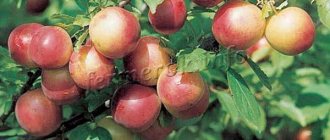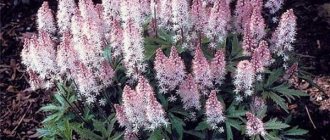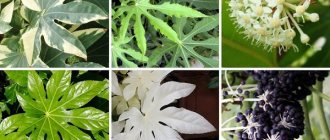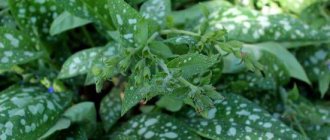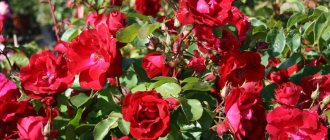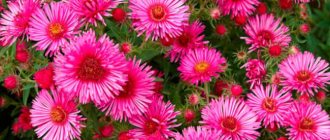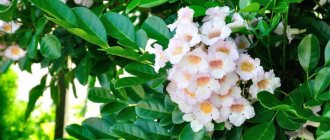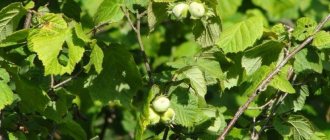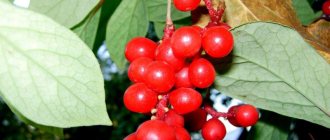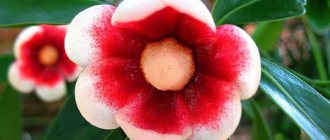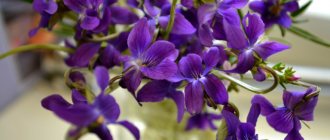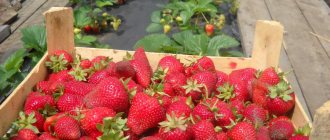Banana (Musa) is a herbaceous fruit plant from the Banana family. Under natural conditions it is found in the tropical zones of Ecuador, Australia, and Mexico .
The banana is native to the Hindustan Peninsula, Southeast Asia. Developing in genetically favorable conditions, it grows up to 10 m, and its fruits are considered a berry. In Europe, the plant is a decoration for greenhouses and is grown in greenhouses.
A banana grows easily and quickly at home, where it can increase its height by 1 meter in a year. Indoors, the plant's lifespan is short - only about 5 years. During this time, it manages to grow up to 2 m. It blooms for the first time at the age of 3 years.
At the very end of the trunk it forms cone-shaped inflorescences. After fruiting ends, the stem dies and is revived with shoots.
Be sure to pay attention to such wonderful plants as medinilla and anthurium.
| It grows easily and quickly at home, where it can increase its height by 1 meter in a year. |
| Blooms for the first time at the age of 3 years. |
| The plant is easy to grow. |
| Life expectancy is about 5 years. |
Beneficial features
Homemade banana (Musa).
Photo Homemade banana is a delicious fruit that is eaten raw and processed. Fruits are a source of vitamins PP, A, E, C, B; potassium, iron, phosphorus and calcium; sucrose and organic acids. They are used in folk medicine to increase hemoglobin levels and reduce blood pressure. Tryptophan contained in banana improves mood.
Anti-inflammatory and anti-burn agents are prepared from banana parts. Homemade banana is used in cosmetology. Fishing gear and ropes are woven from the stem and leaves. Homemade flowers are fertilized with infusion of the peel.
Features of growing at home. Briefly
If you create favorable conditions for the plant, it is not difficult to grow a banana at home. Optimal for him:
| Temperature | In winter - + 18 - 21°C, in summer - + 26 - 30°C. |
| Air humidity | High, from 65%; use humidifiers; sprayed frequently. |
| Lighting | Bright; windows facing south, southwest, southeast. |
| Watering | Abundant; in winter – once, and in summer – up to 3 times a week; warm shower. |
| Priming | Special “Soil for Banana” or prepare a mixture of two doses of leaf soil and part of peat, sand and turf soil. |
| Feeding and fertilizer | In summer and spring, once every 7 days, apply universal mineral and organic fertilizer in diluted form; do not feed in autumn and winter. |
| Transfer | Every year, in the spring. |
| Reproduction | Lateral shoots, seeds, dividing the bush. |
| Features of cultivation | There are peculiarities of growing, knowing which you can properly care for it. The bush needs fresh air; on warm summer days it is often taken out for a walk and left in a place protected from drafts. |
Caring for bananas at home. Details
Despite the fact that tropical latitudes are far from central Russia, it is easy to grow a banana at home if you know its preferences.
Bloom
When it grows well and forms 16 - 17 large wide leaves (usually this happens already at the age of three), it may bloom in mid-summer .
The leaves gather at the top in the form of an umbrella. When a heart-shaped leaf forms at the very top, a large inflorescence appears from the center of the rosette in the form of small cream or greenish flowers collected in a panicle.
As it blooms, it will increase (in nature, the length of the panicle can reach 1.5 m) and fall down. The process can last for 2 or 3 months.
Flowers can be bisexual or heterosexual. After pollination of female flowers, bean-shaped fruits are formed, united in a brush - “banchu”. The leaves eventually bend downwards and fall off over time.
Temperature
A native of the hot tropics, he is very thermophilic. It is important for him to maintain a special temperature regime throughout the year.
In summer, the plant is kept at + 26 - 30°C, in winter - at + 18 - 21°C.
Spraying
As befits a guest from the tropics, homemade banana prefers high air humidity (from 65%). It is difficult to create such conditions in an apartment, especially during the heating season. Therefore, every day the plant is sprayed 3-4 times (in winter - up to 2 times); The pot is placed on a tray with wet expanded clay. An open container of water is placed next to it, and air humidifiers are used.
Lighting
Prefers bright sunlight . The quality of its growing season directly depends on the amount of ultraviolet rays received, so caring for a banana at home strongly recommends keeping the plant on windows facing south, southwest or southeast.
If you place it in a less-lit area, it will refuse to bloom, stop growing, and never set fruit. On the other hand, the southern part of the house should be shaded in hot weather to avoid sunburn.
Watering
Loves plenty of moisture. To ensure that the soil always remains moist, bananas are watered up to 3 times in the summer, and once a week in winter .
Sometimes watering is replaced with a lukewarm shower (it will remind the plant of the warm tropical rains in its homeland).
After the shower, leave it in the bathroom for a while to let the water drain. For irrigation use settled lukewarm water.
Pot
Throughout the growing season, the banana pot will have to be changed several times. The smallest container for it is the volume of which is 2 liters, the largest is 50 liters. By purchasing a banana seedling about 65 cm high, you can transplant it directly into a 20-liter pot at home.
There is no need to buy a pot that is too large: a spacious container will cause acidification of the substrate, which will lead to rotting of the roots. But there is no need for a cramped container: it will not develop in it. There should be drainage holes at the bottom of the pot to prevent stagnation of moisture. When choosing a suitable container, you must take into account that at least 1/3 of the volume of the container should be occupied by the drainage layer.
Priming
The banana plant at home grows harmoniously in a nutritious, breathable substrate that has neutral acidity. Special soil for bananas with the same name can be bought in the store. You can make the soil mixture yourself from one portion of turf soil, sand and peat and two parts of leaf soil. Particles of sphagnum, coconut substrate and vermiculite added to the substrate will make it more loose.
Feeding and fertilizer
During the entire period of active growing season, fertilizing and fertilizer are required. Once a week after watering, alternately use organic and universal mineral fertilizers in diluted form. After feeding, the home banana should be kept in shade for 24 hours.
Transfer
The plant develops intensively, so bananas are replanted every spring.
Young bushes are replanted twice a year. By this time, the roots begin to protrude on the surface of the substrate or look out from the drainage holes. The volume of the new pot should be 3–4 cm larger than the previous one. A thick layer of drainage made of broken brick, expanded clay or pebbles is placed on the bottom.
When replanting, homemade banana should be slightly deepened so that adventitious roots are formed, and then the yield increases. Replanting is replaced by transshipment so as not to damage the roots of the plant. In mature plants, the top layer of soil is refreshed.
After transshipment or renewal of the top layer of soil, the banana is well watered and placed on a tray with wet expanded clay, placing several plastic bottle caps under the container so that air is blown through the holes in the bottom of the pot.
After 2 days, the soil is carefully loosened. After 3 weeks, the plant is fed.
Trimming
Banana Covendish.
Photo In indoor conditions, banana pruning is not carried out. But some gardeners, wanting to rejuvenate the perennial plant, cut indoor bananas at the root. After this, new shoots appear.
Rest period
It differs from other plants in that it does not have a dormant period. Throughout the year, the plant requires high humidity and warmth. But in winter, they provisionally set aside time for the tree to rest, keep it at a favorable temperature of + 20°C, stop feeding and water less often.
When do banana fruits grow?
If optimal conditions are created in the apartment (sufficiently high temperature and humidity, excellent lighting), the homemade banana will bear fruit. If it is grown from a scion, this will happen in a year or two. A plant obtained from seeds will enter the fruiting phase later - after 4 years. To stimulate the formation of fruits, fertilizing is carried out.
Practical use
In medicine
This fruit has many beneficial properties! Traditional medicine says that banana is one of the most acceptable foods for gallstone disease. Bananas are good for liver diseases and gastrointestinal diseases. The pulp of this berry is rich in fiber and dietary fiber, which has a beneficial effect on the digestion process, as well as potassium salts, which promote the removal of fluid from the body and good heart function. Scientists have proven that people who eat a banana daily are more optimistic and focused.
In gardening
Banana fruits can also be used as fertilizer for indoor and garden plants. Everything is clear with gardeners, I threw the skins into a compost pit and fertilized the beds the next year, but how do you fertilize or feed indoor plants with bananas? Its peel contains a lot of potassium, which is so necessary for the growth and development of plants. Banana peels can be used as dry food for home flowers. To do this, the skin is dried, then ground or ground into powder. The resulting mass can be mixed with soil or sprinkled directly under the roots of flowers.
Reproduction
Reproduction is possible by three methods:
Growing banana from seeds
Difficult because of their hard shell. To get rid of it, the seeds are soaked in water for several days, and then the shell is ground off with a manicure file or sandpaper. The prepared seeds are placed in moist soil and buried slightly. Cover with film and germinate at + 30°C. Shoots appear after 2.5 months. The film is removed to ventilate and water the seedlings. Grown seedlings are transplanted into a large container.
Banana propagation by division
Combined with transshipment of plants. A fragment with the resulting shoot is cut off from an adult rhizome, the cut area is sprinkled with coal powder and planted in the ground.
Banana propagation by shoots
Occurs when a fragment with several leaves is separated from a formed rhizome. The cut areas are dusted with crushed soil. The shoot is planted in the substrate.
The shoots and fragments of the bush take root well, so these propagation options are more often used.
How to propagate indoor banana
Dwarf bananas are usually propagated by seeds, propagules, or vegetative methods. Each of them has its own characteristics.
Seeds
If you wish, you can get the seeds yourself:
- wrap the yellow banana in plastic wrap until the peel completely darkens and the fruit softens;
- peel the fruit and cut lengthwise without touching the core;
- remove the seeds and place them on paper or a napkin;
- select full seeds and discard flat ones;
- rinse the seeds to remove pulp;
- fill with water for 2-3 days;
- rinse again and dry well.
Attention! A plant grown from seeds is completely decorative - the fruits are not suitable for food. With this method it will be possible to raise only wild animals. But uncultivated grass will be stronger and more resistant to disease.
The seeds are germinated in sphagnum moss or coconut fiber. This material is purchased in special stores, after which it is steamed, mixed with perlite, and spilled with a weak solution of potassium permanganate. An alternative is a mixture of peat and sand in a ratio of 3/1.
For germination, drainage material is placed in the container, with a substrate on top, 5-6 cm thick. The seed coat is broken by scratching or sawing. The container must be covered with polyethylene to create a greenhouse effect. Daytime temperatures can reach 33 °C, night temperatures can reach 20-25 °C. Germination is a long procedure, up to 2-3 months.
Children
Varietal indoor banana plants are grown only from root shoots, dividing the rhizome into parts. With such propagation, all the qualities of the mother plant are preserved.
Reproduction from root shoots
Vegetatively
Cultivated varieties also reproduce vegetatively from an adult plant. This can speed up the ripening process, and as a result, the fruits will grow in just 2 years.
Diseases and pests
The indoor banana is a powerful plant; only with improper care can complications arise in its development. Diseases attack the tree and pests sometimes cause damage.
Ill health manifests itself in signs:
- does not grow - lack of lighting, cramped pot (transplant into a larger container and move to a brighter place);
- banana leaves dry around the edges - due to dry air (spray more often, place on a tray with wet pebbles, use air humidifiers);
- black-brown spots appear on the leaves - root rot from excess moisture (remove damaged roots, sprinkle cut areas with coal powder, replant in new soil);
- dark spots on the leaves of young bananas are a varietal feature of some types of banana; as they mature, the leaves become green;
- the sprout dries and dies - a natural physiological process that completes the fruiting of the plant;
- slimy rot on the stem - spraying or waterlogging the soil at low temperatures (remove damaged parts, treat the remaining parts with a fungicide, adjust watering).
They can affect scale insects, spider mites, and thrips.
Growing problems
What diseases are typical for indoor banana trees? How to help an exotic plant? Let's look at the most common difficulties that anyone may encounter:
- Slowing growth, reduction, and wilting of foliage may be due to a lack of nutrients. To begin with, you can carry out a series of planned fertilizing, and you can transplant it into a larger pot.
- Drying of foliage, wilting of young shoots, curling and yellowing of tips - all this is associated with dry air. It is necessary to spray the crown more often and increase the overall humidity in the room.
- Pale and small foliage appears due to a lack of consecration. It is recommended to use artificial lamps in winter.
- Soft drooping leaves signal to us that the room temperature is too low. That is why indoor bananas are more vulnerable in winter. The plant should not be located near “cold” windows or in drafts.
- Dark pigmentation between the veins on older leaves is common and is not something to worry about.
- In the spring, the plant did not come out of the dormant period and did not begin to actively grow? Then you need to carry out scheduled feeding.
- The stem darkened at the base and became soft. This is the worst sign of all! The base of the stem rots from an excess of soil moisture; if watering is not reduced and urgent measures are not taken, the plant may soon die.
Fruit bananas (the fruits of which can be eaten)
Grown for its abundance of tasty fruits. Developed from two known species: Banana Balbis and Banana acuminate. Popular varieties are:
Super Dwarf Cavendish Banana (Musa acuminate Super Dwarf Cavendish)
A low-growing variety with dense pale green leaves. The flower is bright red. Fruits abundantly.
Dwarf Cavendish banana (Musa acuminate Super Dwarf Cavendish)
Low fertile variety. The bright green leaf blades are wide and large. Burgundy flower.
It is still rarely found in apartments. Fans of indoor exotics like the plant with its powerful silhouette, large leaves and spectacular flowers. The giant plant looks good in a spacious room with high windows. Large space allows the plant to develop harmoniously and emphasizes its uniqueness.
Decorative leafy and beautifully flowering bananas
Bananas of this type are valued for their beautiful large flowers and leaves. Their fruits are inedible or differ from edible ones by a large number of coarse small seeds.
Chinese dwarf banana, Golden lotus (Musella lasiocarpa)
The height of the plant is up to 100 cm. Large leaf plates are painted in emerald color. Forms a large golden inflorescence.
Blood banana (Musa sumatrana Zebrina)
The leaf blades are wide, “decorated” with a fancy burgundy-green pattern. The small red fruits are inedible.
Velvet banana (Musa velutina)
Along the edge of the oval pale green leaves there is a scarlet edging. The flower is large and bright pink. The red fruits are conditionally edible.
Types of bananas:
- Velvety banana (Musa velutina) is a plant with inedible fruits, up to 1.3 meters high.
- Banana Kiev dwarf – begins to bear fruit at 3 years of age. Flowering is long, lasting from 3 months to a year. The fruits are sweet, not miniature.
- plants.
- There are many cultivars of the sterile triploid cultigen Musa × paradisiaca (an artificial species not found in the wild) which are widely cultivated in tropical countries and constitute a major export in many of them.
- Japanese banana (Musa basjoo), native to the Japanese Ryukyu Islands, is grown as an ornamental plant on the Black Sea coast of the Caucasus, Crimea and Georgia.
